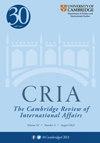Ideology’s iron embrace, Joseph Fletcher Prize Forum
IF 1.3
3区 社会学
Q2 INTERNATIONAL RELATIONS
引用次数: 0
Abstract
Click to increase image sizeClick to decrease image size Disclosure statementNo potential conflict of interest was reported by the author.Notes1 This contrasts notably with the discussion in Weeks (Citation1992).2 One may quibble a bit. The AAF shift to urban bombing occurred after D-Day, preceded by a focus on the Third Reich’s oil infrastructure and, counterintuitively, the German fighter force. The general inaccuracy of bombing, noted by Bessner, did ensure that AAF bombs often intended for industrial targets fell on residential zones instead (Overy Citation2013, 171–230).3 By the account of his aide and friend, Michael Žantovský, violence in the former Soviet republics and resurgent Russian nationalism alarmed him (Žantovský Citation2014, 437–439).Additional informationNotes on contributorsRobert RakoveRobert Rakove is a lecturer in International Relations at Stanford University. He is the author of Kennedy, Johnson, and the Nonaligned World, published by Cambridge University Press in 2012, and Days of Opportunity: The United States and Afghanistan Before the Soviet Invasion, published by Columbia University Press in 2023.意识形态的铁怀抱,约瑟夫·弗莱彻奖论坛
点击放大图片点击缩小图片披露声明作者未报告潜在的利益冲突。注1这与Weeks (Citation1992) 2中的讨论形成了明显的对比有人可能会吹毛求疵。空军航空兵在诺曼底登陆日之后转向城市轰炸,在此之前,重点是第三帝国的石油基础设施,以及与直觉相反的德国战斗机部队。Bessner指出,轰炸的普遍不准确性确实确保了AAF炸弹通常用于工业目标而不是落在居民区(Overy Citation2013, 171-230)根据他的助手和朋友迈克尔Žantovský的说法,前苏联共和国的暴力和俄罗斯民族主义的复兴使他感到震惊(Žantovský Citation2014, 437-439)。作者简介robert Rakove是斯坦福大学国际关系专业的讲师。他著有《肯尼迪、约翰逊和不结盟世界》(剑桥大学出版社于2012年出版)和《机遇的日子:苏联入侵前的美国和阿富汗》(哥伦比亚大学出版社于2023年出版)。
本文章由计算机程序翻译,如有差异,请以英文原文为准。
求助全文
约1分钟内获得全文
求助全文

 求助内容:
求助内容: 应助结果提醒方式:
应助结果提醒方式:


